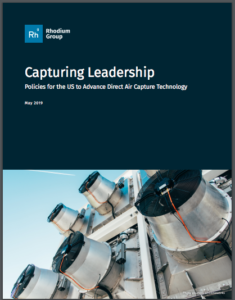Full Title: Capturing Leadership: Policies for the US to Advance Direct Air Capture Technology
Author(s): John Larsen, Whitney Herndon, Mikhail Grant, and Peter Marsters
Publisher(s): Rhodium Group
Publication Date: May 9, 2019
Full Text: Download Resource
Description (excerpt):
Growing evidence suggests that limiting global temperature increases to reasonably safe levels will require not only a rapid reduction in carbon dioxide (CO2) and other greenhouse gas emissions (GHGs) around the world but large-scale removal of CO2 from the atmosphere as well. Every year that global emissions continue unabated, the required pace of future reductions accelerates, and the quantity of CO2 emissions that ultimately needs to be removed from the atmosphere grows. Fortunately, thanks to recent technological innovations, the options for CO2 removal are increasing in number and falling in cost. But significant policy action is required to ensure these technologies are available in time and at the scale required to avoid the worst impacts of climate change.
This report focuses on one of these emerging carbon removal technologies: Direct Air Capture (DAC). DAC safely removes CO2 from the air using chemical filters and produces a concentrated stream of CO2 for use in products like concrete and fuels or for permanent geologic storage. Carbon180, the Linden Trust for Conservation, and the ClimateWorks Foundation asked Rhodium Group to conduct an independent analysis of the role DAC can play in supporting a decarbonized US future, its cost, and the actions required to achieve deployment at a scale that can have a global impact on reducing GHGs in the near, medium and long term.
We studied the latest peer-reviewed literature and conducted dozens of expert interviews to understand the state of the technology today concerning performance and costs. We modeled DAC’s role in a decarbonized US future, using trailblazing analysis to measure long-term need. We then developed a detailed set of policy options that can both accelerate the deployment of DAC and support the technology at the scale required for the US to deliver its contribution toward avoiding the worst impacts of climate change. Our key findings follow.
